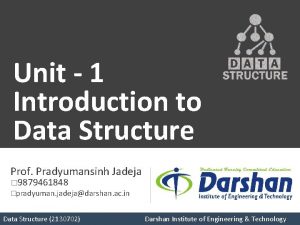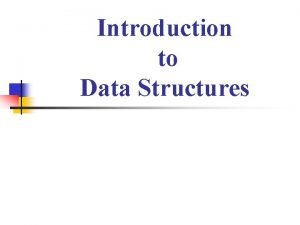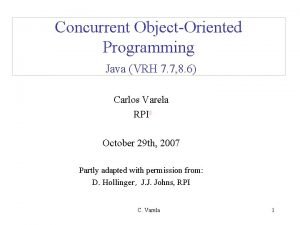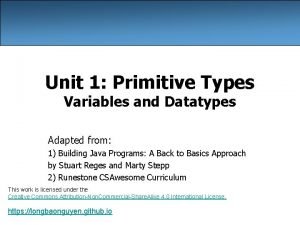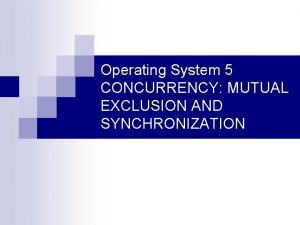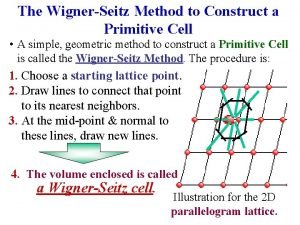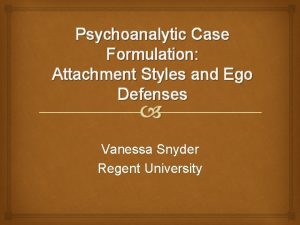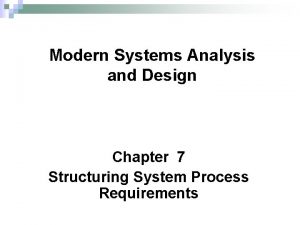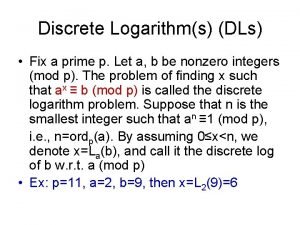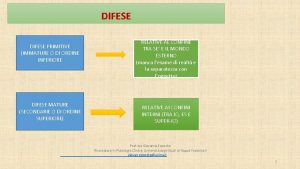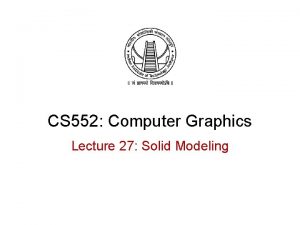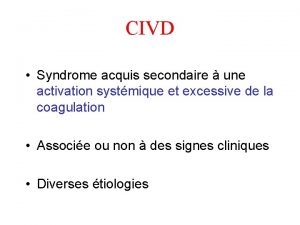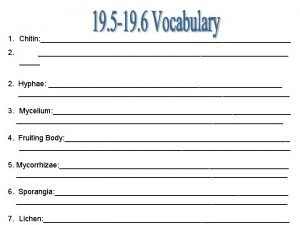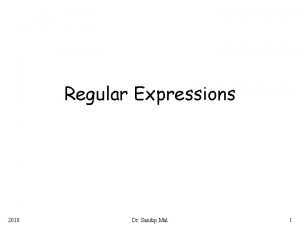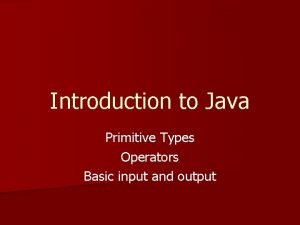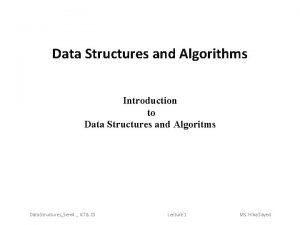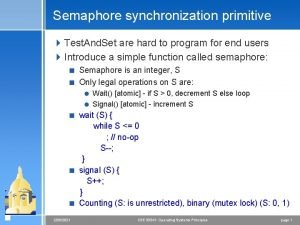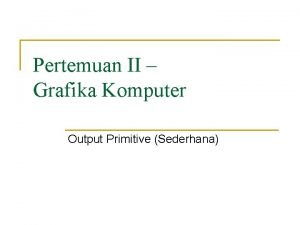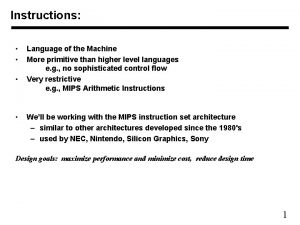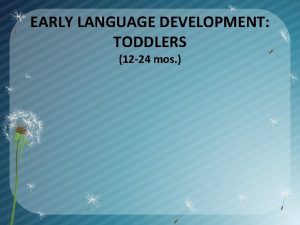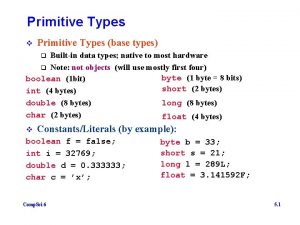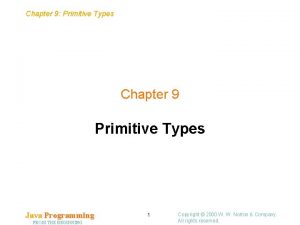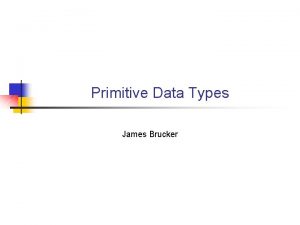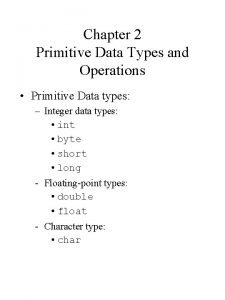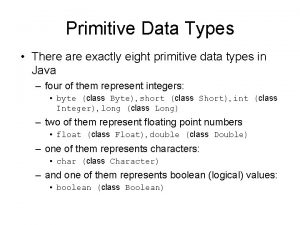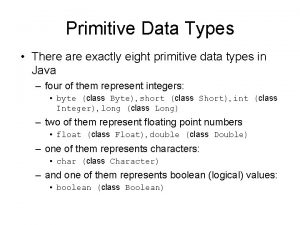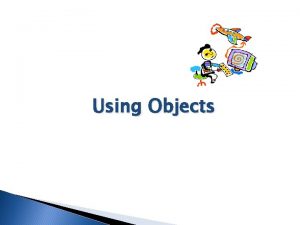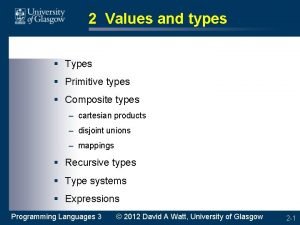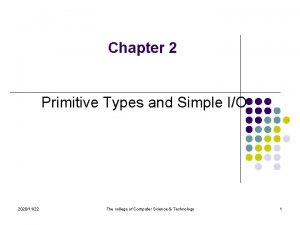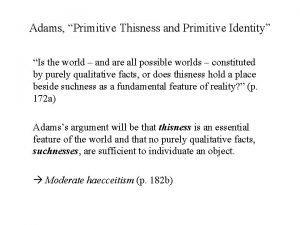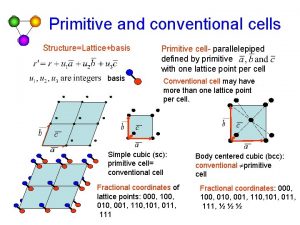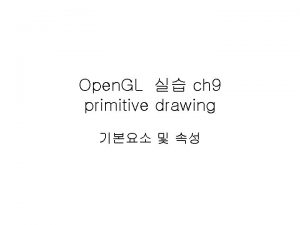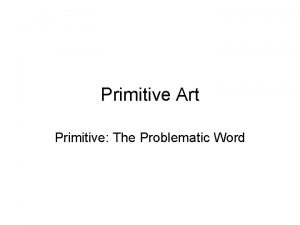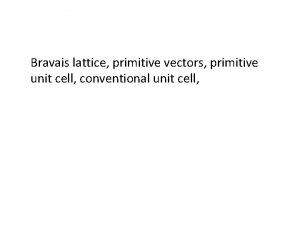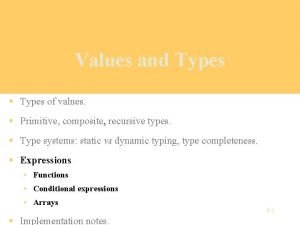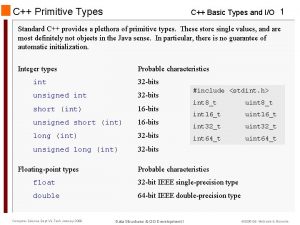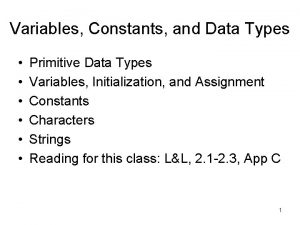Chapter 2 Primitive Types and Simple IO l
















































- Slides: 48

Chapter 2 Primitive Types and Simple I/O l l l Chapter 2 Primitive Data types Strings: a class Assignment Expressions Keyboard and Screen I/O Documentation & Style Java: an Introduction to Computer Science & Programming - Walter Savitch 1

What is a program variable? Chapter 2 l A named location to store data » a container for data l It can hold only one type of data » for example only integers, only floating point (real) numbers, or only characters Java: an Introduction to Computer Science & Programming - Walter Savitch 2

Creating Variables l All program variables must be declared before using them l A variable declaration associates a name with a storage location in memory and specifies the type of data it will store: Type Variable_1, Variable_2, …; l For example, to create three decimal variables to store the purchase price, tax amount, and total cost: double purchase. Price, tax; double total; Chapter 2 Java: an Introduction to Computer Science & Programming - Walter Savitch 3

Assigning Values to Variables l l The assignment operator: “=“ Not the same as in algebra It means “Assign the value of the expression on the right side to the variable on the left side. ” Can assign in same statement as declare, can have the variable on both sides of the equals sign: int count = 0; // initialize counter to ten count = count + 1; // increment counter » new value of count = 0 + 1 = 1 Chapter 2 Java: an Introduction to Computer Science & Programming - Walter Savitch 4

Assigning Initial Values to Variables Initial values may or may not be assigned when variables are declared: //This is not initialized when declared //and has unknown value double purchase. Price; l Chapter 2 Programming tip: it is good programming practice to initialize variables if you know what the value should be. Java: an Introduction to Computer Science & Programming - Walter Savitch 5

Changing the Value of a Variable l Usually the value is changed (assigned a different value) somewhere in the program l May be calculated from other values: total = purchase. Price + tax ; l or read from keyboard input: purchase. Price = Savitch. In. read. Line. Double(); Chapter 2 Java: an Introduction to Computer Science & Programming - Walter Savitch 6

Variable Names: Identifiers Rules - these must be obeyed l all Java identifiers must follow the same rules l must not start with a digit l must contain only numbers, letters, underscore (_) and $ (but avoid using $, it is reserved for special purposes) l names are case-sensitive (This. Name and this. Name are two different variable names) l No Spaces!! (or dots!) Chapter 2 Good Programming Practice - these should be obeyed l always use meaningful names from the problem domain (for example, purchase. Price instead of n, which is meaningless) l start variable names with lower case l capitalize interior words (use purchase. Price instead of purchaseprice ) l avoid using $ since it is reserved for special purposes Java: an Introduction to Computer Science & Programming - Walter Savitch 7

Two Main Kinds of Types in Java primitive data types l l the simplest types cannot decompose into other types values only, no methods Examples: int – integer (whole number) double - floating point (real) char - character Chapter 2 class types l l l more complex composed of other types (primitive or class types) both data and methods Examples: Savitch. In String Later we will define others (such as Student) Java: an Introduction to Computer Science & Programming - Walter Savitch 8

Primitive Data Types Chapter 2 Java: an Introduction to Computer Science & Programming - Walter Savitch 9

Which Ones are Most Common l l int » just whole numbers » may be positive or negative » no decimal point char » just a single character » uses single quotes » for example char letter. Grade = `A`; boolean Chapter 2 double » real numbers, both positive and negative » has a decimal point (fractional part) » two formats – number with decimal point, e. g. 514. 061 – e (or scientific, or floatingpoint) notation, e. g. 5. 14061 e 2, which means 5. 14061 x 102 Java: an Introduction to Computer Science & Programming - Walter Savitch 10

Literals / Unnamed Constants double low. Score = 200; // 200 is a literal l count = count + 1; // 1 is a literal l char grade = ‘A’; // ‘A’ is a literal l Can name constants (good idea) l public static final double tax. Rate = 0. 07; l (Java convention to name constants with all caps (TAXRATE)) l Chapter 2 Java: an Introduction to Computer Science & Programming - Walter Savitch 11

Named Constants l l l Chapter 2 Named constant—using a name instead of a value Example: use MORTGAGE_INTEREST_RATE instead of 8. 5 Advantages of using named constants » Easier to understand program because reader can tell how the value is being used » Easier to modify program because value can be changed in one place (the definition) instead of being changed everywhere in the program. » Avoids mistake of changing same value used for a different purpose Java: an Introduction to Computer Science & Programming - Walter Savitch 12

Defining Named Constants public static final double PI = 3. 14159; public—no restrictions on where this name can be used static—must be included, but explanation has to wait final—the program is not allowed to change the value l The remainder of the definition is similar to a variable declaration and gives the type, name, and initial value. l A declaration like this is usually at the beginning of the file and is not inside the main method definition. Chapter 2 Java: an Introduction to Computer Science & Programming - Walter Savitch 13

Specialized Assignment Operators l l A shorthand notation for performing an operation on and assigning a new value to a variable Examples: amount += 5; //amount = amount + 5; amount *= 1 + interest. Rate; //amount = amount * (1 + interest. Rate); Note that the right side is treated as a unit (equivalent to having parentheses around the entire expression) General form: var <op>= expression; » equivalent to: var = var <op> (expression); » <op> is +, -, *, /, or % Chapter 2 Java: an Introduction to Computer Science & Programming - Walter Savitch 14

More Specialized Assignment Operators l Adding 1 is so common that an even shorter notation was desired count = count + 1; count += 1; count++; // are all equivalent l l Called increment operator Can subtract too time--; Chapter 2 Java: an Introduction to Computer Science & Programming - Walter Savitch 15

Increment and Decrement Operators l The counter can be incremented (or decremented) before or after using its current value int count; … ++count preincrement count: count = count + 1 before using it count++ postincrement count: count = count + 1 after using it --count predecrement count: count = count -1 before using it count-- postdecrement count: count = count -1 after using it Chapter 2 Java: an Introduction to Computer Science & Programming - Walter Savitch 16

Increment and Decrement Operator Examples If used in a statement by itself, pre vs post doesn’t matter (people use post) l However, it can be used in the middle of a statement l Quiz - common code int n = 3; int m = 4; int result; l What will be the value of m and result after each of these executes? (a) result = n * ++m; //preincrement m (b) result = n * m++; //postincrement m (c) result = n * --m; //predecrement m (d) result = n * m--; //postdecrement m l l I strongly urge you to not do stuff like this Chapter 2 Java: an Introduction to Computer Science & Programming - Walter Savitch 17

Answers to Increment/Decrement Operator Questions (a) 1) m = m + 1; //m = 4 + 1 = 5 2) result = n * m; //result = 3 * 5 = 15 (b) 1) result = n * m; //result = 3 * 4 = 12 2) m = m + 1; //m = 4 + 1 = 5 (c) 1) m = m - 1; //m = 4 - 1 = 3 2) result = n * m; //result = 3 * 3 = 9 (b) 1) result = n * m; //result = 3 * 4 = 12 2) m = m - 1; //m = 4 - 1 = 3 l Chapter 2 I strongly urge you to not do stuff like this Java: an Introduction to Computer Science & Programming - Walter Savitch 18

Returned Value l Expressions return values: the number produced by a method or expression is “returned”, i. e. it is the “return value. ” double purchase. Price, tax, total; purchase. Price = Savitch. In. read. Line. Int(); // value returned is then assigned double tax. Rate = 0. 07; tax = purchase. Price * tax. Rate; » in the last line the variables return their present values » purchase. Price * tax. Rate is an expression that returns the value calculated – the returned value is used in the assignment Chapter 2 Java: an Introduction to Computer Science & Programming - Walter Savitch 19

Assignment Compatibilities l l Chapter 2 You cannot put a value of one type in a variable of a different type unless it is converted to match the type of the variable Conversion of types is called casting Java: an Introduction to Computer Science & Programming - Walter Savitch 20

Implicit Casting l l l Casting is done implicitly (automatically) when a “lower” type is assigned to a “higher” type The data type hierarchy (from lowest to highest): byte --> short --> int --> long --> float --> double For example: double x; int n = 5; x = n; » the value returned by n is cast to a double, then assigned to x » x contains 5. 000… (as accurately as it can be encoded as a floating point number) » This is called implicit casting because it is done automatically » The data type of the variable n is unchanged; is still an int Lowest types have least info – when converting to higher type, no info Java: is anlost e. g. 5 5. 0 Chapter 2 Introduction to Computer Science & Programming - Walter Savitch l 21

Data Types in an Expression: More Implicit Casting l l l Chapter 2 Some expressions have a mix of data types All values are automatically advanced (implicitly cast) to the highest level in the expression before the calculation For example: double a; int n = 2; float x = 5. 1; double y = 1. 33; a = (n * x)/y; // parens as in math » n is automatically cast to type float before the multiplication, then that result is automatically cast to double before the division Java: an Introduction to Computer Science & Programming - Walter Savitch 22

What about the “Other” way? l Going to a lower type … int n; double x = 2. 4; n = x; Information would be lost (there’s no room for the. 4 in n) l You must explicitly say that’s what you want – Java will not allow otherwise. l Chapter 2 Java: an Introduction to Computer Science & Programming - Walter Savitch 23

Explicit Casting l l l Explicit casting changes the data type of the value for a single use of the variable For example: int n; double x = 2. 4; n = (int)x; » the value of x is converted from double to integer before assigning the value to n Syntax: Precede the variable name with the new data type in parentheses: (<data type>) variable. Name » the type is changed to <data type> only for the single use of the returned value where it is cast » x is still 2. 4 – n is 2 Chapter 2 Java: an Introduction to Computer Science & Programming - Walter Savitch 24

Truncation When Casting a double to an Integer l Converting (casting) a double to integer does not round; it truncates l l Chapter 2 » the fractional part is lost (discarded, ignored, thrown away) For example: int n; double x = 2. 99999; n = (int)x; //cast is required, x is truncated » the value of n is now 2 This behavior is useful for some calculations, but for others it is something to be wary about Java: an Introduction to Computer Science & Programming - Walter Savitch 26

Truncation When Doing Integer Division l l l No truncation occurs if at least one of the values in a division is type float or double (all values are promoted to the highest data type) Truncation occurs if all the values in a division are integers For example: int a = 4, b =5, c; double x = 1. 5, y; y = b/x; //value returned by b is cast to double //value of y is approximately 3. 33333 c = b/a; //all values are ints so the division //truncates: the value of c is 1! Chapter 2 Java: an Introduction to Computer Science & Programming - Walter Savitch 27

GOTCHA: Imprecision of Floating Point Numbers l l Chapter 2 Computers store numbers using a fixed number of bits, so not every real (floating point) number can be encoded precisely » an infinite number of bits would be required to precisely represent any real number For example, if a computer can represent up to 10 decimal digits, the number 2. 5 may be stored as 2. 49999 if that is the closest it can come to 2. 5 Integers, on the other hand, are encoded precisely » if the value 2 is assigned to an int variable, its value is precisely 2 This is important in programming situations you will see later in the course Java: an Introduction to Computer Science & Programming - Walter Savitch 28

The Modulo Operator: a%b l l Chapter 2 Used with integer types Returns the remainder of the division of b by a For example: int a = 57; b = 16, c; c = a%b; » c now has the value 9, the remainder when 57 is divided by 16 A useful operation: see determining even or odd on p 71 or Case Study: Vending Machine Change Java: an Introduction to Computer Science & Programming - Walter Savitch 29

Vending Machine Change Excerpt from the Change. Maker. java program: int amount, original. Amount, quarters, dimes, nickels, pennies; . . . // code that gets amount from user not shown original. Amount = amount; If amount is 90 then quarters = amount/25; there 80/25 will be 3, so amount = amount%25; there are three quarters. dimes = amount/10; amount = amount%10; If amount is 90 then the nickels = amount/5; remainder of 80/25 will be 15, amount = amount%5; so 15 cents change is made up of other coins. pennies = amount; Chapter 2 Java: an Introduction to Computer Science & Programming - Walter Savitch 30

Arithmetic Operator Precedence and Parentheses l Java expressions follow rules similar to real-number algebra – see display 2. 3 l Use parentheses to force precedence l Do not clutter expressions with parentheses when the precedence is correct and obvious Extra parentheses do not hurt, and can aid readability, and help you be safe. l Chapter 2 Java: an Introduction to Computer Science & Programming - Walter Savitch 31

Examples of Expressions Chapter 2 Java: an Introduction to Computer Science & Programming - Walter Savitch 32

The char Data Type l l Chapter 2 The char data type stores a single “printable” character For example: char answer = `y`; System. out. println(answer); » prints (displays) the letter y Java: an Introduction to Computer Science & Programming - Walter Savitch 33

Characters as Integers l Characters are actually stored as integers according to a special code » each printable character (letter, number, punctuation mark, space, and tab) is assigned a different integer code » the codes are different for upper and lower case » for example 97 may be the integer value for ‘a’ and 65 for ‘A’ l l l Chapter 2 ASCII (Appendix 3) and Unicode are common character codes Unicode includes all the ASCII codes plus additional ones for languages with an alphabet other than English Java uses Unicode Java: an Introduction to Computer Science & Programming - Walter Savitch 34

Casting a char to an int l l Casting a char value to int produces the ASCII/Unicode value For example, what would the following display? char answer = `y`; System. out. println(answer); System. out. println((int)answer); l Chapter 2 Answer: the letter ‘y’ on one line followed by the ASCII code for ‘y’ (lower case) on the next line: >y >89 > Java: an Introduction to Computer Science & Programming - Walter Savitch 35

The String Class l l l A string is a sequence of characters The String class is used to store strings The String class has methods to operate on strings String constant: one or more characters in double quotes Examples: char. Variable = `a`; //single quotes String string. Variable = "a"; //double quotes String sentence = “Please enter a value between 1 and 50"; Chapter 2 Java: an Introduction to Computer Science & Programming - Walter Savitch 36

String Variables Chapter 2 l Declare a String variable: String greeting; l Assign a value to the variable greeting = "Hello!"; l Use the variable as a String argument in a method: System. out. println(greeting); » causes the string Hello! to be displayed on the screen Java: an Introduction to Computer Science & Programming - Walter Savitch 37

Concatenating (Appending) Strings Stringing together strings - the “+” operator for Strings: String name = “Jason"; String greeting = "Hi, there!"; System. out. println(greeting + name + "Welcome"); causes the following to display on the screen: >Hi, there!Jason. Welcome > » Note that you have to remember to include spaces if you want it to look right: System. out. println(greeting + " " + name + " Welcome"); » causes the following to display on the screen: >Hi, there! Jason Welcome > Chapter 2 Java: an Introduction to Computer Science & Programming - Walter Savitch 38

Concatenating (Appending) Strings String name = “Jason”; l String question = “Please type in your age “; l String ask = name + question; l String answer = “Total: “; l String answer = answer + total; // implicit cast l Chapter 2 Java: an Introduction to Computer Science & Programming - Walter Savitch 39

String Methods String is a class – so has methods l Display 2. 6 shows many of them l E. g length l » int len = answer. length( ); // done on answer //object – needs no extra information (arguments) l Chapter 2 Java: an Introduction to Computer Science & Programming - Walter Savitch 40

Indexing Characters within a String l l The index of a character within a string is an integer starting at 0 for the first character and gives the position of the character The char. At(Position)method returns the char at the specified position substring(Start, End)method returns the string from position Start to position End For example: String greeting = "Hi, there!"; char letter = greeting. char. At(0)// returns H char letter 2 = greeting. char. At(2)// returns , String junk = greeting. substring(4, 6)// returns the Chapter 2 Java: an Introduction to Computer Science & Programming - Walter Savitch 41

Escape Characters l l Chapter 2 How do you print characters that have special meaning? For example, how do you print the following string? The word "hard" Would this do it? System. out. println("The word "hard""); » No, it would give a compiler error - it sees the string The word between the first set of double quotes and is confused by what comes after Use the backslash character, “”, to escape the special meaning of the internal double quotes: System. out. println("The word "hard""); //this works Java: an Introduction to Computer Science & Programming - Walter Savitch 42

More Escape Characters Use the following escape characters to include the character listed in a quoted string: " Double quote. ' Single quote. \ Backslash. - you actually get to see a n New line. Go to the beginning of the next line. r carriage return. Go to the beginning of the current line. t Tab. White space up to the next tab stop. Chapter 2 Java: an Introduction to Computer Science & Programming - Walter Savitch 43

One more thing about screen output: how to get or avoid a new line Sometimes you want to print part of a line and not go to the next line when you print again l Two methods, one that goes to a new line and one that does not System. out. println(…); //ends with a new line System. out. print(…); //stays on the same line l For example: System. out. print("This will all "); System. out. println("appear on one line"); l Println goes to a new line AFTER the text l System. out. print() works similar to the “+” operator: System. out. println("This will all " + "appear on one line, too"); (statements can go on more than one line, but don’t interupt in the middle of a string “”’s ) l Chapter 2 Java: an Introduction to Computer Science & Programming - Walter Savitch 44

Program I/O l l l Chapter 2 I/O - Input/Output Keyboard is the normal input device Screen is the normal output device Classes are used for I/O They are generally add-on classes (not actually part of Java) Some I/O classes are always provided with Java, others are not Java: an Introduction to Computer Science & Programming - Walter Savitch 45

I/O Classes l We have been using an output method from a class that automatically comes with Java: System. out. println() l But Java does not automatically have an input class, so one must be added » Savitch. In is a class specially written to do keyboard input Savitch. In. java is provided with the text - see Appendix 2 Examples of Savitch. In methods for keyboard input: read. Line. Int() read. Line. Double() read. Line. Nonwhite. Char() l l l Chapter 2 Gotcha: remember Java is case sensitive, for example read. Line. Non. White. Char()will not work Java: an Introduction to Computer Science & Programming - Walter Savitch 46

Keyboard Input Gotchas Note the two variations for reading each type of number read. Line variation l l Chapter 2 reads a whole line asks the user to reenter if it is not the right format Try to use these Examples: read. Line. Int() read. Line. Double() read variation l l reads just the number aborts the program if it is not the right format Avoid using these Examples: read. Int() read. Double() Java: an Introduction to Computer Science & Programming - Walter Savitch 48

Documentation and Style l l l Chapter 2 Use meaningful names for variables, classes, etc. Use indentation and line spacing as shown in the examples in the text – show what is part of what Always document your program with comments Use all lower case for variables, except capitalize internal words (eggs. Per. Basket) Use all upper case for variables that have a constant value, PI for the value of pi (3. 14159…) (see text for more examples) Java: an Introduction to Computer Science & Programming - Walter Savitch 50

Comments l l Comment—text in a program that the compiler ignores Does not change what the program does, only explains the program Write meaningful and useful comments include a “prologue” (an brief explanation of the program at the beginning of the file) » Author, date created and modified, explanation of program as a whole l Comment the non-obvious – e. g radius in inches Assume a reasonably knowledgeable reader – I will give guidelines later // for single-line comments /* … */ for multi-line comments l Self documenting programs are a myth, an excuse l l l Chapter 2 Java: an Introduction to Computer Science & Programming - Walter Savitch 51
 Non primitive data structure
Non primitive data structure Classification of data structure
Classification of data structure Why array index starts with 0
Why array index starts with 0 Unit 1 primitive types
Unit 1 primitive types Present simple, past simple, future simple
Present simple, past simple, future simple Primitive root in cryptography
Primitive root in cryptography Semaphore provides a primitive yet powerful and flexible
Semaphore provides a primitive yet powerful and flexible Difference between primitive and classical mythology
Difference between primitive and classical mythology Present simple and future simple
Present simple and future simple Present simple past simple future simple
Present simple past simple future simple Past simple future
Past simple future Without information
Without information Present simple past simple future simple exercise
Present simple past simple future simple exercise Simple present tense simple past tense simple future tense
Simple present tense simple past tense simple future tense Present simple tense
Present simple tense Future simple present simple
Future simple present simple Wigner seitz unit cell
Wigner seitz unit cell Primitive defense mechanisms
Primitive defense mechanisms パラシュート反射
パラシュート反射 What is political socialization
What is political socialization Cleft and pouch
Cleft and pouch Physical activity was historically primitive.
Physical activity was historically primitive. Primitive dfd
Primitive dfd Baby reflexes chart
Baby reflexes chart Primitive streak is formed from
Primitive streak is formed from Primitive genre cycle
Primitive genre cycle Primitive root
Primitive root Difese primitive
Difese primitive Solid modeling in computer graphics
Solid modeling in computer graphics Hexagonal unit cell
Hexagonal unit cell Volume maille quadratique
Volume maille quadratique Fibrinolyse primitive
Fibrinolyse primitive Primitive fungi
Primitive fungi Primitive regular expressions
Primitive regular expressions Primitive
Primitive Semaphore semmelweis
Semaphore semmelweis Psychosexual development
Psychosexual development Preductal vs postductal
Preductal vs postductal Non primitive data structure
Non primitive data structure Thyroid diverticulum
Thyroid diverticulum Primitive subsistence agriculture
Primitive subsistence agriculture Primitive testing 4
Primitive testing 4 Primitive fire starting
Primitive fire starting Output primitive
Output primitive Primitive instructions
Primitive instructions Pre spanish period physical education
Pre spanish period physical education Dore's primitive speech acts chart
Dore's primitive speech acts chart Gastrulation
Gastrulation Phonon momentum
Phonon momentum
